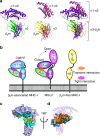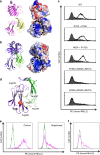Structure of MHC class I-like MILL2 reveals heparan-sulfate binding and interdomain flexibility
- PMID: 30337538
- PMCID: PMC6193965
- DOI: 10.1038/s41467-018-06797-8
Structure of MHC class I-like MILL2 reveals heparan-sulfate binding and interdomain flexibility
Abstract
The MILL family, composed of MILL1 and MILL2, is a group of nonclassical MHC class I molecules that occur in some orders of mammals. It has been reported that mouse MILL2 is involved in wound healing; however, the molecular mechanisms remain unknown. Here, we determine the crystal structure of MILL2 at 2.15 Å resolution, revealing an organization similar to classical MHC class I. However, the α1-α2 domains are not tightly fixed on the α3-β2m domains, indicating unusual interdomain flexibility. The groove between the two helices in the α1-α2 domains is too narrow to permit ligand binding. Notably, an unusual basic patch on the α3 domain is involved in the binding to heparan sulfate which is essential for MILL2 interactions with fibroblasts. These findings suggest that MILL2 has a unique structural architecture and physiological role, with binding to heparan sulfate proteoglycans on fibroblasts possibly regulating cellular recruitment in biological events.
Conflict of interest statement
The authors declare no competing interests.
Figures




Similar articles
-
A family of MHC class I-like genes located in the vicinity of the mouse leukocyte receptor complex.Proc Natl Acad Sci U S A. 2002 Oct 15;99(21):13687-92. doi: 10.1073/pnas.212375299. Epub 2002 Oct 7. Proc Natl Acad Sci U S A. 2002. PMID: 12370446 Free PMC article.
-
A role for the MHC class I-like Mill molecules in nutrient metabolism and wound healing.Immunol Cell Biol. 2008 Aug-Sep;86(6):489-96. doi: 10.1038/icb.2008.41. Epub 2008 Jun 17. Immunol Cell Biol. 2008. PMID: 18560379
-
MHC class I-like MILL molecules are beta2-microglobulin-associated, GPI-anchored glycoproteins that do not require TAP for cell surface expression.J Immunol. 2006 Sep 1;177(5):3108-15. doi: 10.4049/jimmunol.177.5.3108. J Immunol. 2006. PMID: 16920948
-
Structural diversity of class I MHC-like molecules and its implications in binding specificities.Adv Protein Chem Struct Biol. 2011;83:223-70. doi: 10.1016/B978-0-12-381262-9.00006-9. Adv Protein Chem Struct Biol. 2011. PMID: 21570669 Review.
-
The adaptable major histocompatibility complex (MHC) fold: structure and function of nonclassical and MHC class I-like molecules.Annu Rev Immunol. 2013;31:529-61. doi: 10.1146/annurev-immunol-032712-095912. Epub 2013 Jan 7. Annu Rev Immunol. 2013. PMID: 23298204 Review.
Cited by
-
CLEC10A can serve as a potential therapeutic target and its level correlates with immune infiltration in breast cancer.Oncol Lett. 2022 Jun 28;24(2):285. doi: 10.3892/ol.2022.13405. eCollection 2022 Aug. Oncol Lett. 2022. PMID: 35814828 Free PMC article.
-
Biophysical research in Hokkaido University, Japan.Biophys Rev. 2020 Apr;12(2):233-236. doi: 10.1007/s12551-020-00649-w. Epub 2020 Apr 28. Biophys Rev. 2020. PMID: 32347462 Free PMC article. No abstract available.
References
Publication types
MeSH terms
Substances
LinkOut - more resources
Full Text Sources
Molecular Biology Databases
Research Materials

